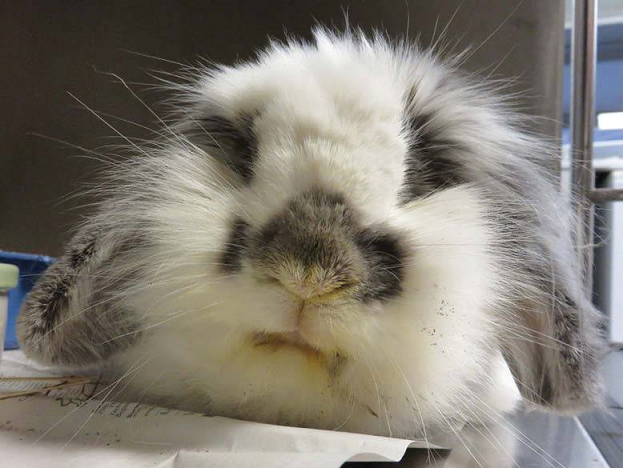Difference between revisions of "Rabbit Medicine and Surgery: Self-Assessment Color Review, Second Edition, Q&A 20"
Jump to navigation
Jump to search
(Created page with "{{CRC Press}} {{Student tip |X = highly relevant to practice}} <br><br><br> centre <br> '''Pasteurella multocida is commonly in...") |
|||
| Line 5: | Line 5: | ||
[[File: Rabbit_Medicine_and_Surgery_Q20.PNG|centre]] | [[File: Rabbit_Medicine_and_Surgery_Q20.PNG|centre]] | ||
<br> | <br> | ||
| − | '''Pasteurella multocida is commonly involved in respiratory disease in rabbits (see image).''' | + | '''''Pasteurella multocida'' is commonly involved in respiratory disease in rabbits (see image).''' |
<br><br><br> | <br><br><br> | ||
<FlashCard questions="1"> | <FlashCard questions="1"> | ||
|q1= How can this infection be controlled and prevented? | |q1= How can this infection be controlled and prevented? | ||
| − | |a1= Serological screening for P. multocida and barrier housing have been used to establish Pasteurella-free colonies in laboratory rabbits and large breeding facilities. However, pet rabbits are unlikely to originate from Pasteurella-free sources and a high percentage of normal healthy rabbits carry this bacterium as a commensal organism in their respiratory tract. Prevalence increases with age and clinical signs depend on the immune status of the host, virulence, and strain of bacterium involved. Therefore, carrying out serological screening for P. multocida, quarantining positive animals and treating infected rabbits is likely to have little effect on the control of Pasteurella in a multi-rabbit household. Careful attention to any contributing factors will decrease the individual’s susceptibility to infection. Common contributing factors include stress due to malnutrition, chronic disease, husbandry problems (high ammonia levels), social changes and environmental problems (overheating, poor ventilation). Immunosuppression due to corticosteroid therapy or immune system disease will also predispose the rabbit to this infection. Excellent husbandry practices, such as good ventilation and hygiene, and reducing any stressors will reduce the incidence of this disease. New animals should be quarantined and observed for respiratory signs prior to being introduced to other pet rabbits. Vaccines have been developed against P. multocida in laboratory rabbits, although none are currently available for prevention of pasteurellosis in pet rabbits in the UK. | + | |a1= Serological screening for ''P. multocida'' and barrier housing have been used to establish ''Pasteurella''-free colonies in laboratory rabbits and large breeding facilities. However, pet rabbits are unlikely to originate from ''Pasteurella''-free sources and a high percentage of normal healthy rabbits carry this bacterium as a commensal organism in their respiratory tract. Prevalence increases with age and clinical signs depend on the immune status of the host, virulence, and strain of bacterium involved. Therefore, carrying out serological screening for ''P. multocida'', quarantining positive animals and treating infected rabbits is likely to have little effect on the control of ''Pasteurella'' in a multi-rabbit household. Careful attention to any contributing factors will decrease the individual’s susceptibility to infection. Common contributing factors include stress due to malnutrition, chronic disease, husbandry problems (high ammonia levels), social changes and environmental problems (overheating, poor ventilation). Immunosuppression due to corticosteroid therapy or immune system disease will also predispose the rabbit to this infection. Excellent husbandry practices, such as good ventilation and hygiene, and reducing any stressors will reduce the incidence of this disease. New animals should be quarantined and observed for respiratory signs prior to being introduced to other pet rabbits. Vaccines have been developed against ''P. multocida'' in laboratory rabbits, although none are currently available for prevention of ''pasteurellosis'' in pet rabbits in the UK. |
|l1= Replace text with name and subsection of relevant WikiVet page if in existence eg. Feather - Anatomy & Physiology#Structure & Function | |l1= Replace text with name and subsection of relevant WikiVet page if in existence eg. Feather - Anatomy & Physiology#Structure & Function | ||
</FlashCard> | </FlashCard> | ||
Revision as of 11:29, 22 November 2018
| This question was provided by CRC Press. See more case-based flashcards |

|
Student tip: This case is highly relevant to practice |
Pasteurella multocida is commonly involved in respiratory disease in rabbits (see image).
| Question | Answer | Article | |
| How can this infection be controlled and prevented? | Serological screening for P. multocida and barrier housing have been used to establish Pasteurella-free colonies in laboratory rabbits and large breeding facilities. However, pet rabbits are unlikely to originate from Pasteurella-free sources and a high percentage of normal healthy rabbits carry this bacterium as a commensal organism in their respiratory tract. Prevalence increases with age and clinical signs depend on the immune status of the host, virulence, and strain of bacterium involved. Therefore, carrying out serological screening for P. multocida, quarantining positive animals and treating infected rabbits is likely to have little effect on the control of Pasteurella in a multi-rabbit household. Careful attention to any contributing factors will decrease the individual’s susceptibility to infection. Common contributing factors include stress due to malnutrition, chronic disease, husbandry problems (high ammonia levels), social changes and environmental problems (overheating, poor ventilation). Immunosuppression due to corticosteroid therapy or immune system disease will also predispose the rabbit to this infection. Excellent husbandry practices, such as good ventilation and hygiene, and reducing any stressors will reduce the incidence of this disease. New animals should be quarantined and observed for respiratory signs prior to being introduced to other pet rabbits. Vaccines have been developed against P. multocida in laboratory rabbits, although none are currently available for prevention of pasteurellosis in pet rabbits in the UK.
|
Link to Article | |
To purchase the full text with your 20% off discount code, go to the CRC Press Veterinary website.
